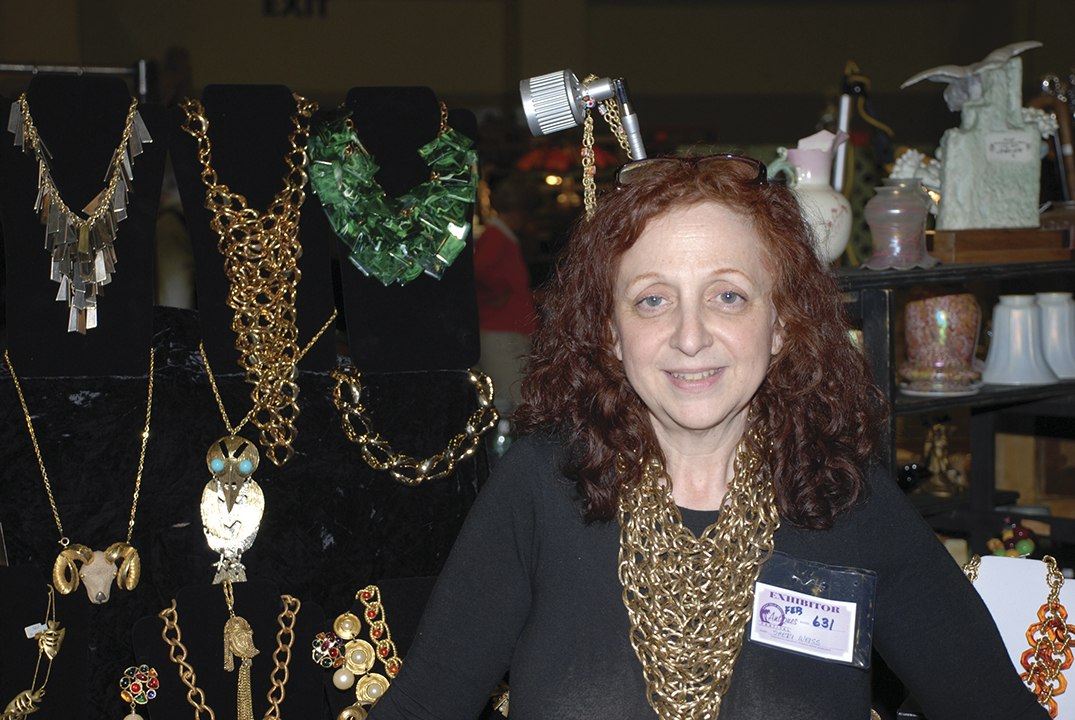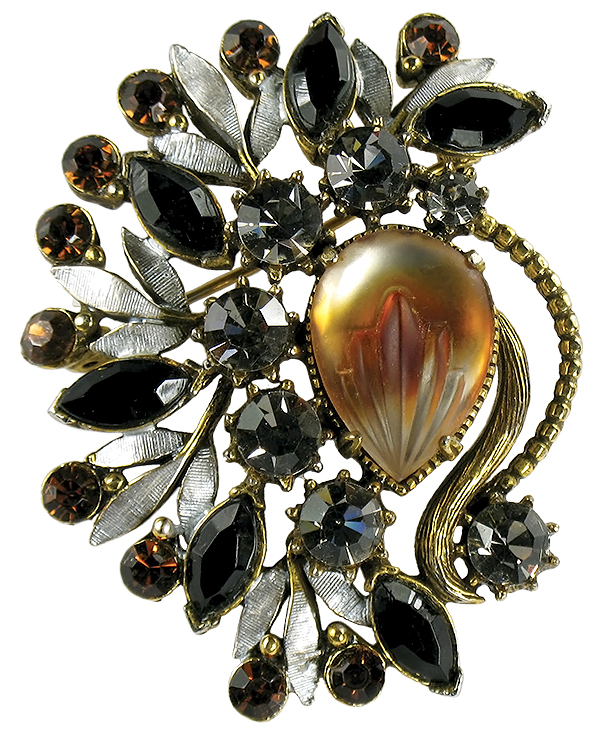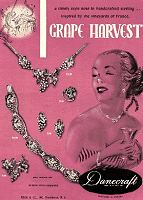
Napier Enameled Jewelry 1950-1990 by Melinda L. Lewis
April 15, 2013
West Palm Beach Antiques Festival 2010
April 21, 2013
CAPTURING THE DESIGN AND CREATING THE PIECE
When we hold a piece of costume jewelry, we typically wonder, “Who made it?” followed by “When was it made?” and “What was it made of?” The question we ask less often is: “How was it made?”
The journey from design concept to finished piece, however, is actually quite fascinating. The fabrication process for nearly all metal-based costume jewelry falls into one of three broad categories: cast, die stamp and manipulated construction. Let’s explore these methods that were, and still are, used to create costume jewelry.

CASTING: LOST-WAX AND SPIN CASTING METHODS
One of the most remarkable processes is lost-wax casting. In spite of the name, this doesn’t refer to a long-lost method, but instead, to the fact that an original wax model is “lost” by being melted during the creation of a production mold.
First, a designer or artist creates a model (master pattern) from wax, clay, wood, plastic, metal or other material. Wax is typically used for costume jewelry models, as it can capture tiny details and nuances of shape. The model is impressed into a two-part master mold (die) that is made from plaster or rubber.  The mold is then hardened to capture the inverse design. Working models (wax patterns) are made by pouring liquid wax into the master mold, and allowing the wax to harden. The two-part mold is then opened to remove the wax model.
The mold is then hardened to capture the inverse design. Working models (wax patterns) are made by pouring liquid wax into the master mold, and allowing the wax to harden. The two-part mold is then opened to remove the wax model.
If a single piece is being manufactured, a pouring channel (sprue) template is attached to the working model. If the piece is small, or is a component rather than a single piece of jewelry, multiple models may be assembled on a wax runner (tree). The final mold (investment) is made by placing the wax pattern or runner into a container (flask) and pouring in a liquid material (usually plaster or ceramic powder mixed with water).
The mold is allowed to dry completely, then is turned upside down and placed in a heating unit to melt out the wax. This is done very quickly to avoid cracking or breaking the mold, allowing some of the wax to liquefy and drain as the remaining wax continues to expand. Using high heat, the mold is burned out to remove any residual wax and moisture. The mold is then firmly secured in a frame or other structure with the opening facing upwards. The metal to be used for the casting has already been measured, heated and liquefied, and is poured into the mold. The mold may be placed in a centrifuge or vacuum machine to assure that the metal completely fills all crevices. If white (pot) metal is being cast, it will harden quickly on its own as it cools, and the mold is broken by hand to release the cast piece. If the metal being cast is silver, the mold is quenched in water. This cools and sets the piece, and shatters the mold.
Since the working mold and wax model are destroyed during lost-wax casting, it is not practical to produce large numbers of white metal pieces using this method. White metal is a mix of different metals that always includes tin and lead with other metals such as bismuth, antimony, cadmium, and copper (not to be confused with precious white metals such as platinum, rhodium, white gold, etc.). It was the basic vintage costume jewelry casting material, and each manufacturer had their own alloy or alloys to be used for casting, with the recipe being a well-guarded trade secret. Lost-wax casting is practical for mass producing sterling silver and precious metal pieces that have a high melting point (for silver, 1700 degrees Fahrenheit or 927 degrees Celsius).
Spin casting, another cast method used to fabricate costume jewelry, is more economical when using white metal, though sometimes a single white metal piece may be lost-wax cast, then used as a model for white metal spin casting. Or a small number of lost-wax cast pieces may be produced to use as salesman samples for a new line of jewelry prior to mass production.
To elaborate on spin casting, this process begins with master models being constructed from metal (possibly using lost-wax casting), wood or another hard material. Multiple models are produced; the smaller the size of the piece, the more that can be included in a single production mold. The models are pressed into one of two pieces of same-size soft rubber rounds that have a center cavity, and pouring lines are made from each model to the center. The second rubber round is placed on top, and the piece is hardened (vulcanized) using a combination of chemicals, pressure and heat. Next, the rubber is cut through the middle and the models are removed from the resulting two-part mold. In place of creating models and molding them in rubber, the rubber could be carved by hand, using a design template.
The rubber mold is then secured in a centrifuge machine, and liquid metal poured or injected in at the center while the mold is spinning. This distributes the metal evenly into the detailed sections of the mold. White metal is ideal for this process as it has a relatively low melting point at 400-550 degrees Fahrenheit (204-288 degrees Celsius), and dries and hardens within seconds. Spin casting can also be used to create thermoset plastic pieces as it is a low-temperature process.
DIE STAMP MANUFACTURING
The second major manufacturing method used to create metal costume jewelry and jewelry components is die stamping. First, a drawing or plaster model is created of the piece or component. If a model is used, it may be coated with liquid rubber and allowed to dry to create a template guide. A highly-skilled tool-and-die maker uses steel tools and a reducing lathe to hand cut and carve a master steel hub, raising the design on the surface. The master hub is struck into a steel block, embedding the image in inverse, making a working die. A forcer die with a raised image is made from the working die. The master hub is never used for actual piece production, as the stamping process would deteriorate the metal over time. Multiple new production dies can always be made, as needed, from the master hub.
Next, the two dies are secured into a machine, with the working die on the bottom and the forcer die on the top. Metal (typically sterling silver or brass) sheeting or individual blanks of an appropriate shape and thickness are selected based on the type and size desired for the finished piece. These are fed into the machine and individual pieces are stamped out in one strike by using a powerful, high-impact hydraulic press. In addition to being used to produce decorative jewelry elements, die stamping was, and still is, the main method for mass producing jewelry findings such as earring clip and screw mechanisms, clip and pin mechanisms, clasps and basic pre-formed stone-setting cups.
Compared to making molds for casting, creating the hubs and dies for die struck jewelry is a more expensive process, as it requires highly-skilled labor. A jewelry tool-and-die maker might be paid as much as eight times the wage of an average factory worker. However, once the initial fabrication steps are completed, mass production of individual die-stamped pieces is generally less expensive, per piece, than producing individual cast pieces.
DIE STAMPING TECHNIQUE
- Blank tool (closed and open) with brass strip and punched blank.
- Power press die-stamping machine; die and forcer set up in the machine for striking.
- Working and forcer dies; finished die-stamped brass floral piece.
During World War II, costume jewelry manufacturers could not use white metal, as all available lead and tin supplies were reserved for producing armaments. Some larger manufacturers such as Coro and Trifari actually used some of their production factories and skilled work forces to create cast metal military parts that were used in the war effort. Sterling silver was widely used for metal costume jewelry production, both cast and die struck, and the 1940’s also saw new and innovative designs using wood, plastics and other materials.
METAL MANIPULATION FABRICATION
The third major method for fabricating metal costume jewelry and components is metal manipulation. A designer first makes a drawing or prototype model of the item. Then, using hand tools such as various pliers, cutters, hammers, etc., metal is shaped to create the piece. This process can be used to make either a completed piece of jewelry or components.
For fine wire-work in brass or silver, jewelry can be made using a jig with pivot points, wrapping the wire repeatedly at different points to form a design. Wire can also be pulled (stretched) to create variations in thickness. Because metal manipulation is being done entirely by hand, no two pieces will be exactly alike.
Post fabrication, all metal jewelry components are finished by one or more steps such as cleaning, touching up edges and mi-nor flaws, tumbling to remove extraneous material, and polishing, soldering and final plating.
FAMILIAR COMPANIES USING THESE METHODS
Vintage costume jewelry manufacturing companies often specialized in only one or two of the major manufacturing processes. For example, Trifari, Florenza, and Hollycraft are marks found mostly on cast pieces. Die-stamped filigrees and manipulated methods bring to mind companies such as Miriam Haskell. Two exceptions to this rule-of-thumb are Coro and Napier; both of these companies mass-produced jewelry using all three of the above mentioned processes for metal fabrication. Knowing a bit about production methods can bring a new appreciation and enjoyment of vintage costume jewelry, and contemporary jewelry also, as all of these manufacturing methods are still used today. Think not only of who, when and what; but now also consider “how did they do that?” when examining your costume jewelry pieces. The basics are provided here to assist in seeking and exploring the answer to this fascinating question.
CJCI Magazine and Mary Ann Docktor-Smith extend their special thanks to Henry Swen (salesman with Napier for 38 years) for sharing his costume jewelry industry knowledge, experiences and insights for this article.
Mary Ann Docktor-Smith is a jewelry dealer, and frequently writes and lectures about vintage costume jewelry. She is an active member of online costume jewelry forums including The Jewelry Ring, a venue for her monthly Jewel Notes from Mary Ann, informative articles with an added touch of humor. Visit Mary Ann online at www.annasvintagejewelry.com.
Jewelry and manipulated technique photos by Mary Ann Docktor-Smith.
Factory die-stamping photos courtesy of Guyot Brothers Company, Inc., Attleboro, Mass., www.guyotbrothers.com.
Casting photos taken by Julie Kosac, courtesy of Ace Casting, Colchester, Vt., www.pblinc.com.
References for this article:
Answers to Questions About Old Jewelry (6th Edition) by C. Jeanenne Bell
Memoirs of a Fashion Jewelry Manufacturer by Frank DeLizza
American Costume Jewelry: Decorative Jewelry Findings and Guyot Brothers in Historical Context by Juliet Friedman, www.guyotbrothers.com/jewelry-history
Jewelry Making Techniques Book by Elizabeth Olver
Related Resources:
Providence Jewelry Museum – examples of vintage models, casting molds, hubs and dies, and machines – www.providencejewelrymuseum.com
Wolf E. Myrow – vintage die stamped components – www.closeoutjewelryfindings.com
Tercat Tool & Die Co. – original Coro hubs – www.tercat.com
Guyot Brothers – history of vintage jewelry production – www.guyotbrothers.com.
Patent Information – searchable using terms such as jewelry casting, die stamp, electroplating, etc. – www.google.com/patents
Click here for Part 2
To view more pictures from this article click here.



